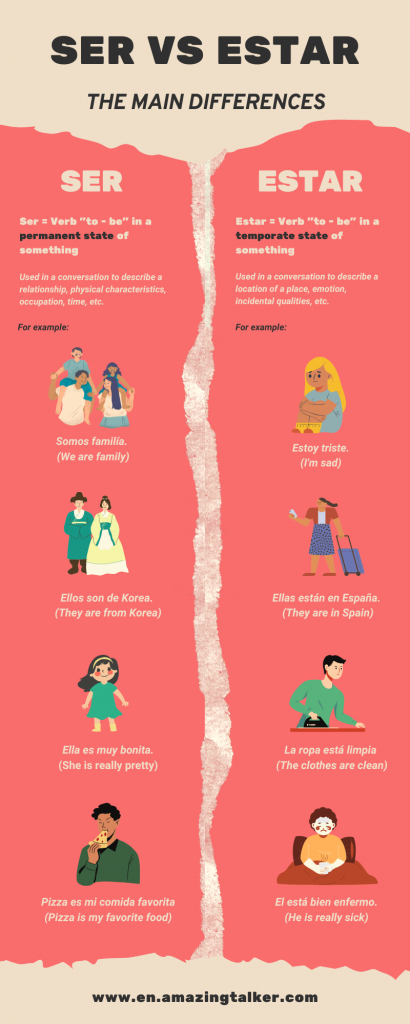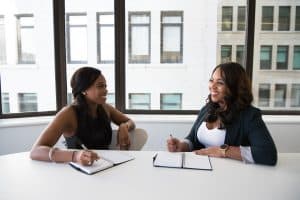Learning the difference between the verbs “ser” vs “estar” can be very confusing since they both mean “To be’ in English! Whereas they mean the same thing, they are used in completely different scenarios. Understanding and learning new and complicated stuff can be very annoying, but with this blog serving as your guide, understanding the difference between “ser” and “estar” will be a breeze and help you learn Spanish fast.

Differences Between “Ser” and “Estar”
Both “Ser” vs “Estar” mean “To be” in English, but in Spanish, they are used in different ways. Ser is used to describe a permanent state of something and what the nature of something is. While, estar describes a temporary state of something.
How to Correctly Use “Ser”
Ser is used to describe the date, occupation, time, characteristic, relation, and origin.
Specifically, ser is used in conversation when the following is being described:
- Relationship of one something to another.
- What the thing is made of/The material.
- What a thing, person, or animal has in its possession.
- Describe the qualities of something.
- Where something is taking place.
- Religion.
- Political Views.
- Nationality.
- Where the thing, person, or animal comes from.
- Occupation.
- The time and date.
How to Correctly Use “Estar”
Estar is used to describe temporary stuff like emotion, condition, location, action, or position. Estar is specifically used to describe the following:
- The physical location of something.
- Progressive tenses are those that end with the suffix -ing.
- Emotions.
- What something is doing.
- The condition of something.
- In what position something is (Where is it standing? Is it standing or sitting?)
- Idiomatic expression.
- Experiences.
Ser and Estar Conjugations
Both Ser and Estar follow an irregular conjugation pattern, which is why they are called irregular verbs. Here is a table containing the indicative present tense (what you are describing at this moment) of Ser and Estar:
| Pronoun | Ser | Estar |
|---|---|---|
| Yo (me) | Soy | Estoy |
| Tú (you) | Eres | Estás |
| Él, ella, usted | Es | Está |
| Nosotros | Somos | Estamos |
| Vosotros | Soís | Estáis |
| Ellos, ellas, ustedes | Son | Están |
For example, when I describe your relationship with someone, I will use Eres. When I describe how you are feeling right now, I will use Estás.

Situational Examples With “Ser and Estar”
Below are some everyday examples and how you would go about using either Estar or Ser:
1. Identifying people or objects
1.1 People:
Ser:
Spanish: ¿Quién es el camarero?
English: Who is the waiter?
We are describing who this person is, and what this person does for a living.
Estar:
Spanish: ¿Disculpa, dónde está nuestro camarero?
English: Sorry, where is our waiter?
We are asking where the temporary location of the waiter is.
1.2 Objects:
Ser:
Spanish: Es rojo.
English: It is red.
We are describing an essential quality of something to identify it:
Estar:
Spanish: ¿Dónde esta lo rojo?
English: Where is the red thing?
We are describing the temporary location of the red object.
2. Occupation
Ser:
Spanish: Él es el director.
English: He is the headmaster.
We are describing who this person is, and what this person does for a living.
Estar:
Spanish: ¿El director está enojado?
English: Is the headmaster angry?
We are asking what emotion the headmaster is feeling at that moment.
3. Time
Ser:
Spanish: Hoy es viernes
English: Today is Friday.
You are stating what day it is.
Estar:
Spanish: Manny está cansado de los lunes.
English: Manny is tired of Mondays.
You are describing a condition of time in Spanish, particularly how Manny feels about Mondays (Me too Manny, me too).
4. Origin
Ser:
Spanish: Ellos son de Korea.
English: They are from Korea.
We are describing the permanent origin of these people.
Estar:
Spanish: Estoy visitando Taiwan.
English: I am visiting Taiwan.
I am describing where I’m going, which is not permanent.
5. Relationships

Ser:
Spanish: Nosotras somos hermanas/hermanos
English: We are siblings.
You are describing your family in Spanish, with whom you are biologically related, which can’t be changed.
Estar:
Spanish: Pablo y Sofia son novios
English: Pablo and Sofia are dating.
We describe their relationship status, which is a condition or a state.
6. Describing Appearance
Ser:
Spanish: Ella es muy bonita
English: She is very pretty.
You are describing a permanent quality of a person.
Estar:
Spanish: Su cabello esta desordenado hoy
English: Her hair is messy today.
This person usually has well-kept hair, except today it is messy. This is not a permanent characteristic.
7. Location
Ser:
Spanish: La fiesta es en mi casa
English: The party is at my house.
I am describing where the party is taking place.
Estar:
Spanish: Mi casa está en Madrid.
English: My house is in Madrid.
I am describing the physical location of where my home is. It may seem permanent, but Estar is used for locations.
8. Talking about Foods
Ser:
Spanish: Pizza es mi comida favorita
English: Pizza is my favorite food
I am describing something about myself, in this case, my love for pizza!
Estar:
Spanish: La pizza está fria
English: The pizza is cold.
We are describing the state of the Spanish word, pizza.
9. Exercise
Ser:
Spanish: Ellas/Ellos son muy atléticas
English: They are very athletic.
We are describing a group of people.
Estar:
Spanish: Ellas/Ellos están emocionadas por hacer ejercicio
English: They are excited about exercising.
We are describing how they feel about exercising.
10. Having a conversation at a restaurant

Ser:
Spanish: La comida es buena aquí
English: The food is good here.
We are describing the qualities of the food at a restaurant.
Estar:
Spanish: El restaurante está muy ocupado.
English: The restaurant is very busy.
We are describing the current state of the restaurant.
11. Express Mood
Ser:
Spanish: ¡Soy una persona muy alegre!
English: I’m a really happy person!
You are describing the overall personality and mood of a person
Estar:
Spanish: Ella está demasiado enoja.
English: She is really angry.
We are describing the current state, mood of a person.
12. On Going Actions
Estar:
Spanish: Ellos están corriendo cerca a la escuela.
English: They are running near the school.
They are describing their current actions.
13. Death
Estar:
Spanish: El perro está muerto.
English: The dog is dead.
They are describing the current action of the dog. Death is considered a state of being in Spanish, and is always used with the verb “estar”.
14. Health
Estar:
Spanish: Todos nosotros, estamos con Covid-19.
English: We all have Covid-19.
We are describing the current state of our health.
15. Weather
Estar:
Spanish: Buenos días. Por sea caso, todo el día, estará lloviendo.
English: Good morning! By the way, it will be raining all day.
We are describing the current state of the weather.

Additional Resources for “Ser vs Estar”
Check out this Youtube video for additional information on how to use “ser vs estar”! In only 7 minutes and 35 seconds, they’ve explained the differences between the two verbs and the situations to each verb in, all in a fun and entertaining manner!
¡Estoy triste de verte partir! (I am sad to see you go)
Learning the most difficult parts of a language doesn’t have to be all that difficult! With this guide, you will easily get the hang of using Ser and Estar!
Are you still struggling with this topic? Or maybe you struggle with another part of the Spanish language. Could it be that you are struggling to comprehend a different language entirely? No problem! All these problems can be solved at AmazingTalker! AmazingTalker is jam-packed with a wide variety of professional language tutors, in this case, online Spanish tutors, that can help you with your learning needs! The website is designed to help you find your perfect tutor, you can even customize the course to suit your learning needs. All of this and more at AmazingTalker.
















